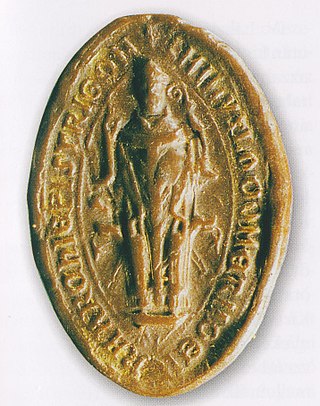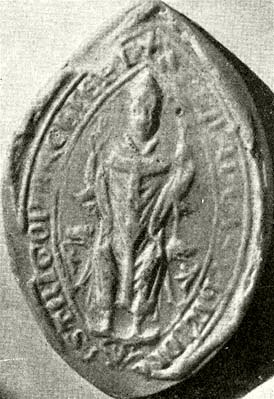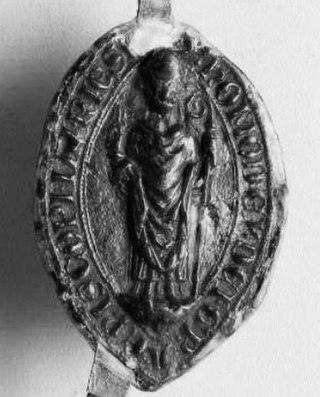Related Research Articles
Stephen (I) Báncsa was the first Hungarian cardinal of the Roman Catholic Church. Prior to that, he served as Bishop of Vác from 1240 or 1241 to 1243, then Archbishop of Esztergom from 1242 until his creation as cardinal.
Matthias from the kindred Rátót was a Hungarian prelate in the first half of the 13th century, who served as Bishop of Vác from 1238 to 1240, then Archbishop of Esztergom from 1239 until his death in the Battle of Mohi. He was the first Archbishop of Esztergom, who was referred to as Primate of Hungary.
Achilles from the kindred Hont-Pázmány was a prelate in the Kingdom of Hungary in the middle of the 13th century. He was provost of the collegiate chapter of Székesfehérvár and vice-chancellor between 1243 and 1251, and bishop of Pécs from 1251 until his death in 1252.

Denis (II) from the kindred Türje or nicknamed Denis the Big-nosed was a powerful Hungarian baron, landowner and military leader in the first half of the 13th century, who held several secular positions during the reign of kings Andrew II and Béla IV. Denis was a childhood friend and staunch supporter of the latter throughout his life. He was the most notable member of the gens Türje.

Robert was a French-born prelate in the Kingdom of Hungary in the first decades of the 13th century. He was Archbishop of Esztergom between 1226 and 1239 and Bishop of Veszprém from 1209 till 1226. He played a decisive role in the establishment of the short-lived Diocese of Cumania. He was sharply opposed to the employment of Jews and Muslims in the administration of the royal revenues. He even put Hungary under interdict to force Andrew II of Hungary to dismiss his non-Christian officials.

Lodomer was a prelate in the Kingdom of Hungary in the second half of the 13th century. He was Archbishop of Esztergom between 1279 and 1298, and Bishop of Várad from 1268 till 1279. He was an opponent of Ladislaus IV of Hungary whom he excommunicated for failing to force the Cumans to adopt the Christian way of life. After Ladislaus' death, Lodomer and his suffragans were dedicated supporters of Andrew III of Hungary, who aimed to restore strong royal power against the rebellious lords and oligarchs.

Hahót or Hahót–Buzád was the name of a gens in the Kingdom of Hungary, several prominent secular dignitaries came from this kindred. The last noble family, which originated from the kindred, became extinct in 1849.

Hermán was the name of a gens in the Kingdom of Hungary. The powerful Lackfi family ascended from this clan.

Denis from the kindred Tomaj was a Hungarian influential baron in the first half of the 13th century, who served as the Palatine of Hungary under King Béla IV from year 1235 to 1241, until his death at the Battle of Mohi.
Báncsa or Bancsa, also incorrectly Vancsa or Vancza, was the name of a gens in the Kingdom of Hungary.

Sixtus was a Hungarian clergyman in the 13th century, who served as a skilled diplomat of King Béla IV of Hungary for decades.
Benedict was a Hungarian prelate in the second half of the 13th century, who served as Archbishop-elect of Esztergom from 1274 until his death. Previously, he held various posts in the royal chancellery.

Philip from the kindred Türje, also known as, albeit incorrectly, Philip of Szentgrót was a Hungarian prelate in the 13th century, who served as Bishop of Zagreb from 1247 or 1248 to 1262, and as Archbishop of Esztergom from 1262 until his death.

Benedict was a Hungarian prelate in the 13th century, who served as Archbishop of Kalocsa from 1241 to 1254, and as Archbishop of Esztergom from 1253 to 1261. As one of the most influential prelates following the Mongol invasion of Hungary, he held the office of royal chancellor for two decades, from 1240 until his death.

Amadeus from the kindred Pok was a Hungarian prelate in the 13th century, who served as Bishop of Győr from 1254 until his death.

Nánabeszter or Nána-Beszter (Nanabezter) was the name of a minor gens in the Kingdom of Hungary, which mostly possessed lands along the river Danube in Central Hungary, around the capitals Esztergom and Buda. After their only known branch, which existed until the early 14th century, the clan was also known as Berki family.
Maurice (II) from the kindred Pok was a Hungarian baron in the 13th century, who served as Master of the treasury from 1262 to 1270. He was a faithful confidant and skilled soldier of King Béla IV of Hungary. The illustrious Meggyesi family descended from him.
Haab was a Hungarian prelate at the turn of the 13th and 14th centuries, who served as Bishop of Vác from 1294 until his death.
File from the kindred Miskolc was a Hungarian clergyman in the 13th century, who served as provost of the cathedral chapter of Zagreb from 1236 until his death. He belonged to the entourage of Coloman, Duke of Slavonia. He functioned as chancellor of the ducal court between 1237 and 1241.
Nicholas (I) from the kindred Gutkeled was a Hungarian baron in the first third of the 13th century, who served as Ban of Slavonia from 1239 or 1240 to 1241, during the reign of Béla IV of Hungary. He was killed in the Battle of Mohi.
References
- ↑ Engel: Genealógia (Genus Hermán 5., Meszes branch)
- 1 2 Karácsonyi 1901, p. 169.